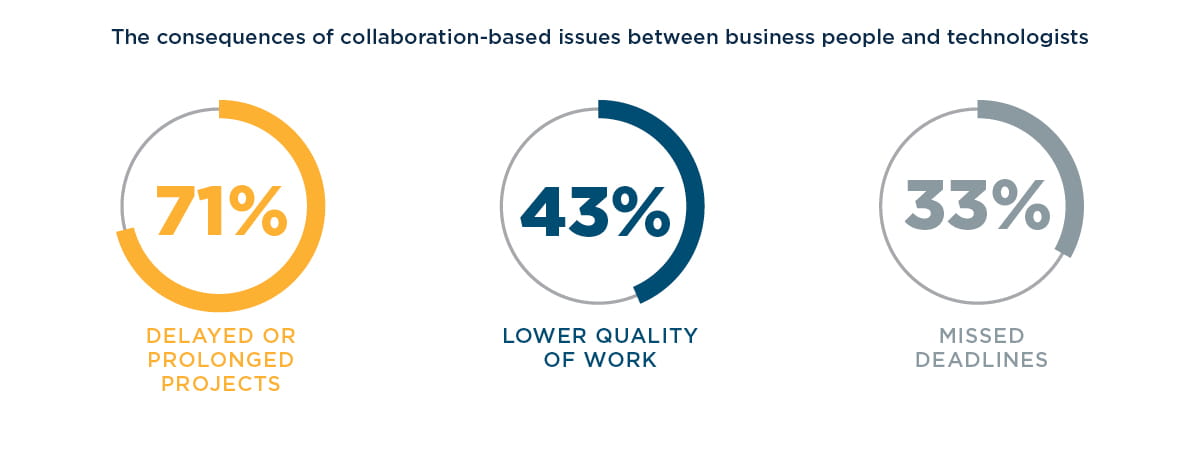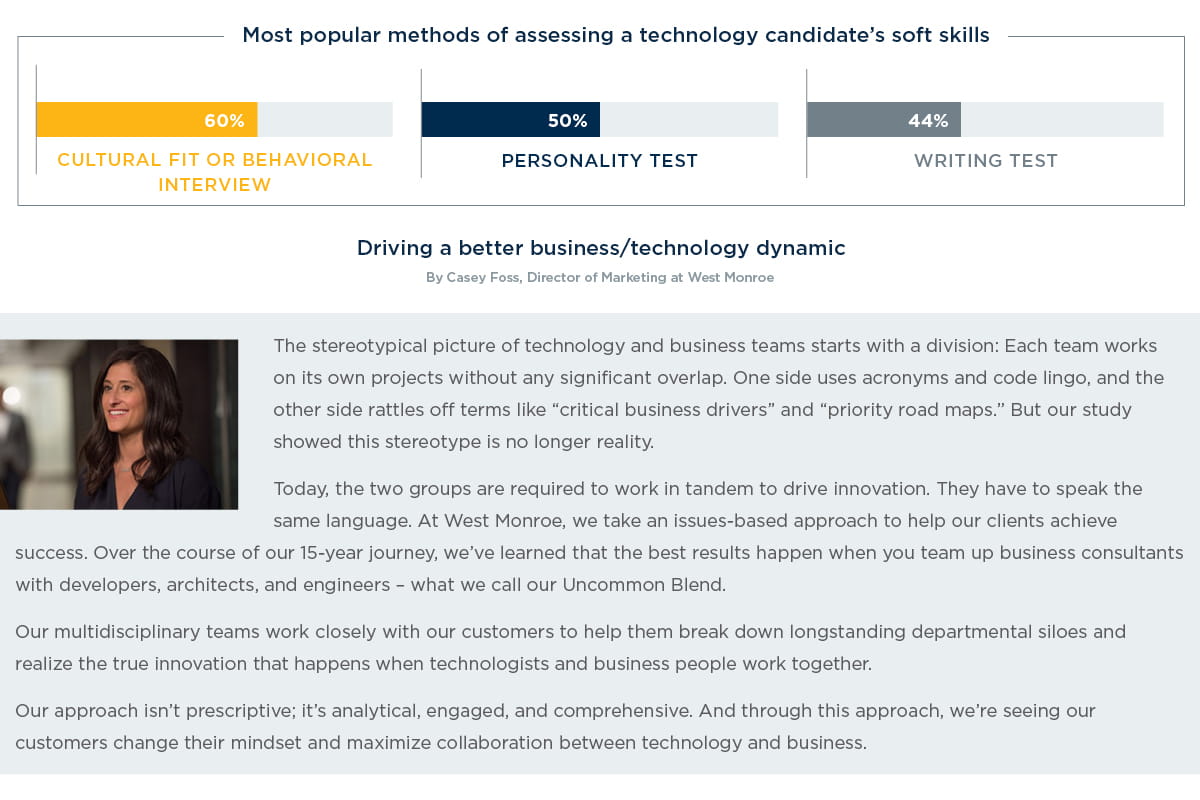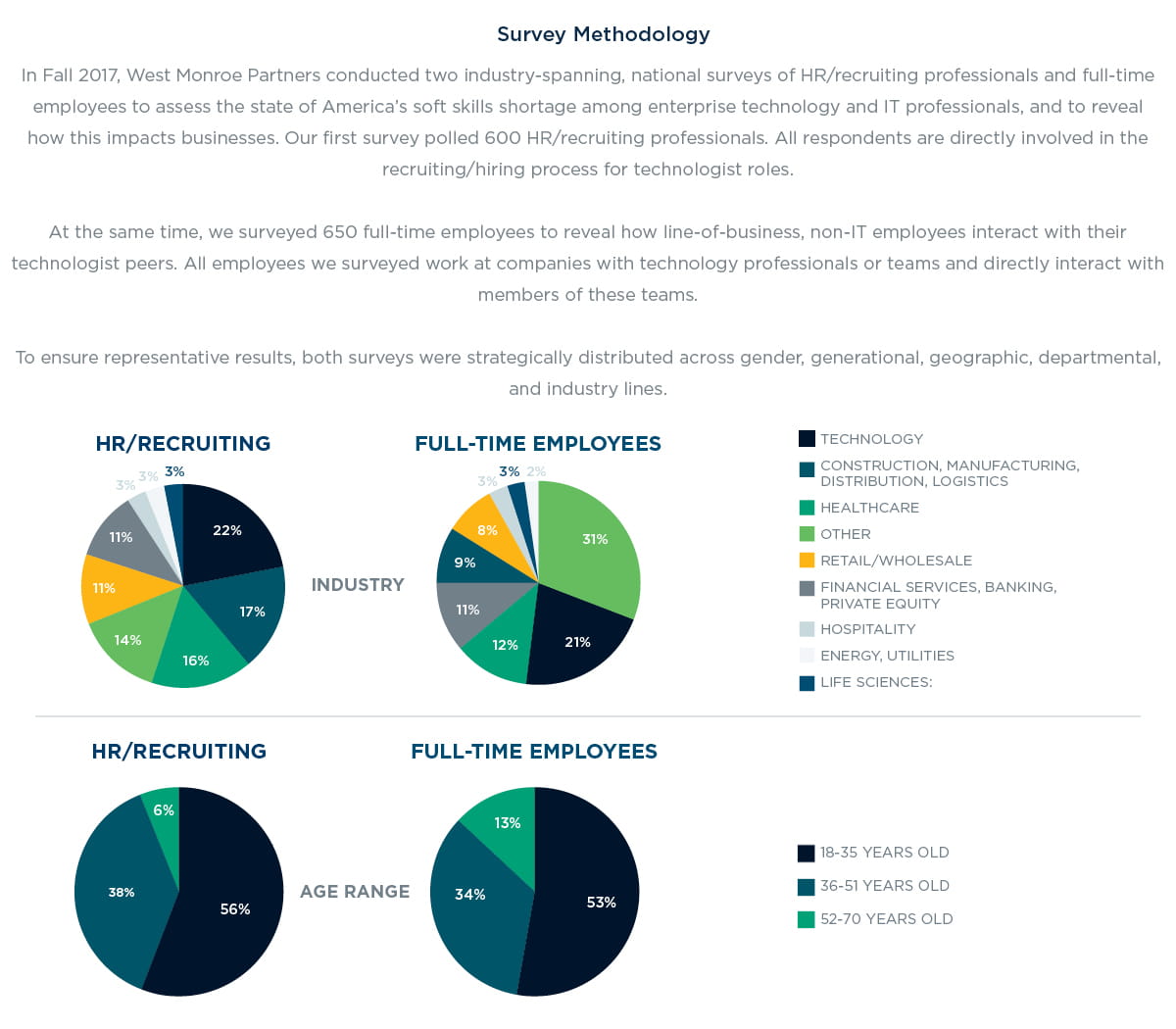
January 2018 | Signature Research
Closing the Technology Leadership Gap
Empowering tech and business teams to work together by focusing on soft skills
Get the full reportWest Monroe conducted a national survey of two distinct audiences to understand the intersection of technology and soft skills. In the survey, we asked more than 600 HR/recruiting professionals about how soft skills factor into the hiring process for technology employees. At the same time, we polled 650 line-of-business professionals on how they work with their technology teams.
Our survey findings demonstrate that most HR professionals understand today’s technology professionals need soft skills in addition to technical capabilities to succeed in their role and add value to the overall organization. And for the most part, business people enjoy working with their technology counterparts. However, the pace of change is likely slowed or impacted by the contrast between the high value recruiters place on soft skills and the actual efforts required to cultivate soft-skilled technologists once they’re hired – leading to collaboration problems down the line.
And while technologists and business people have a good working dynamic, there are three key issues that prevent this collaboration from having the greatest business impact:
- Over 40 percent of business people point to collaboration-based issues with technology teams that hinder work efficiency and timely project completion
- Leadership potential is not being emphasized in hiring or training processes for technologists; as a result, technologists are not viewed as leaders by their peers
- Within companies, soft skills factor into a technology employee’s career advancement, yet businesses don’t provide the necessary training to further develop their IT professionals’ soft skills
These issues can be solved through a combination of more focused hiring strategies, continuous training, and cross-disciplinary alignment.
Introduction
Today’s digital capabilities are drawing up a new world order in business: Companies must be able to adapt at the pace of change that customers expect, with a focus on the technologies engrained in their daily lives.
While this new world order is requiring many organizations to focus on acquiring the hard technical skills to deliver, there is an oft-overlooked component critical to its success: the “soft skills” necessary to develop a new wave of technology leaders. They’re the same skills that are essential to effective collaboration between technologists and business people, which is what drives enterprise success, and the rise of technology leaders.
Now more than ever, soft skills are integral to success in not just a business person’s role, but also a technologist’s role. The new hyperdigital environment requires technology teams (including IT professionals) to be able to deliver more than technical competence, and business people to understand more than the basics of technology. And all of them must be strong communicators, collaborators, team players, and leaders.
“Today’s high-level business initiatives are equal parts business and technology that not only require a common language, but also effective leadership from employees who haven’t always been asked to focus on their soft skills,” said Greg Layok, senior director and leader of West Monroe’s technology practice. “Hard skills are important, but soft skills and technology leadership are just as important to the success of business initiatives.”
Are companies doing enough to identify and foster strong soft skills, especially leadership, among their technology employees? Is it as much as they are doing for business employees? And are business people and technologists collaborating as well as they can?
Chapter 1: Business and technology aren't working as well as they could be
Today’s technologists and business people are working together more than ever. Over the past three years, more than half (53 percent) of businesspeople say the amount they work with their technology teams has increased. This reflects the increasing value technology brings to all aspects of the workplace.
“Enterprise initiatives that really drive value are those that seamlessly merge technology and business strategies from the very beginning,” Layok said. “The idea of a ‘pure’ technology or business initiative is outdated. Today, the two groups share joint accountability on results- driven projects.”
This need for joint accountability requires technology teams and business people to work well together. While 91 percent of employees say they enjoy working with their company’s technology team, there are still areas for improvement. Forty-three percent of business people say they’ve experienced collaboration-based issues working alongside their technology counterparts. The most common reason these issues arise is verbal miscommunication (cited by 62 percent) followed by poor teamwork (44 percent) and written miscommunication (38 percent).
All three of these underlying issues are qualities businesses should formally assess in the hiring process – and continue to develop once teams are onboarded.
“Businesses need to take advantage of the disruptive shift in the dynamic between IT and business,” Layok said. “They should actively look for technologists with the interpersonal, writing, and teamwork abilities to thrive in an integrated business setting and develop into leaders. The challenge is formalizing a process that most effectively evaluates prospects for needed soft skills and leadership potential.”
Soft skills play a decisive role when filling technology rules
Technology jobs aren’t easy to fill: 61 percent of HR leaders say technology roles are either somewhat or extremely more difficult to hire for than other positions.
In a market where qualified technologists are in short supply, adding soft skills and leadership potential into the mix – which 98 percent of HR leaders do – only adds more difficulty to the process. More HR professionals say technology roles are harder to fill because candidates lack strong soft skills (43 percent) vs. those who cite “not enough qualified applicants” (39 percent).
For the most part, HR leaders aren’t letting prospects with subpar soft skills slip through the cracks: Over two-thirds (67 percent) of HR leaders say they have withheld a job offer to an otherwise qualified technology candidate solely because of that candidate’s lack of soft skills.
In the same three-year timeframe that business people say their interactions with their tech teams have increased, more than three- quarters (78 percent) of HR leaders say they’ve become more focused on finding technology employees with strong soft skills.
“The uptick in HR leaders’ focus on soft skills reflects the broader understanding that technology is embedded in business strategy, and vice versa,” Layok said. “Both groups are working toward fulfilling the same strategic business initiatives, so communication and leadership is key.”
The soft skills evaluation: Decision makers get a seat at the table, but leadership takes a back seat
There’s no debating that recruiters are starting to place a higher value on soft skills when filling technology roles, but what does that look like in practice? An examination of how soft skill evaluations play out reveals that while companies have concrete assessment methodologies and are including the proper stakeholders in these evaluations, they’re overlooking one critical skill: leadership potential.
For 60 percent of companies that assess technology candidates’ soft skills, the process includes a cultural fit or behavioral interview. This is an opportunity to bring in business decision makers from outside the HR and technology departments to offer an objective eye about a candidate’s interpersonal skills – something nearly two-thirds of companies do. This outside perspective is often influential: 56 percent of HR leaders say business decision makers’ feedback is very important in determining whether a technology candidate is ultimately hired.
Overall, soft skills evaluations play a pivotal role in determining whether a technology prospect lands a job: 95 percent of HR professionals say the soft skills evaluation is an important component of the technology hiring process. Yet when it comes to valuing leadership potential, HR leaders and business people aren’t on the same page. When given the option to rank soft skills by importance, roughly 4 out of 10 HR leaders (38 percent) cite leadership as the least important soft skill for technology candidates. This was by far the largest category to be ranked as the least important soft skill for technology professionals.
The fact that recruiters aren’t prioritizing leadership has direct consequences in terms of how technology team members are perceived by their peers. Among the business people we surveyed, leadership was most often cited as the weakest soft skill (60 percent said this) among technology professionals.
The fact that technologists aren’t seen as leaders is troubling since leadership is strongly valued on the business side – and it’s inherent to successful enterprise-level projects and innovation.
“From making decisions about enterprise-wide technology adoption to planning and executing SCRUM meetings, to strategically delegating work for group projects, technologists must project confident leadership in order to succeed in today’s more integrated enterprise environment,” said Kevin McCarty, West Monroe’s CEO and a self-professed technologist who rose to a top leadership position.
Chapter 2: Soft skills and career advancement: Expectation exceed training
While it’s important for companies to vet prospective technology candidates for soft skills, it’s even more important to ensure all employees continue to cultivate these abilities on the job. While companies factor soft skills into technologists’ performance reviews, they aren’t focusing as much on providing ongoing training for these skills.
More than three-quarters (78 percent) of companies continue to evaluate technologists’ soft skills as part of their overall performance reviews, and certain soft skills can make or break career advancement within these roles. For instance, 31 percent of HR professionals say verbal communication skills are a requirement to progress within a technology role, while 26 percent consider teamwork/collaboration capabilities a condition of career growth.
Despite the emphasis in performance reviews, businesses aren’t devoting the same degree of focus to relevant IT soft skills training: While 78 percent of companies factor soft skills into performance evaluations, only 59 percent provide soft skills training for employees – a discrepancy that enterprises must address.
“While it’s encouraging that companies factor soft skills into performance reviews, that needs to be matched by a commensurate focus on continuous soft skills training,” McCarty said. “And right now, that’s not happening.”
Chapter 3: Steps toward a results-driven, integrated workplace
Steps toward a results-driven, integrated workplace
Today’s technology teams play a key role in overall business operations, working closely with business people to carry out enterprise-critical functions. But there are communication challenges that stand in the way of an optimally integrated workplace. Surmounting these challenges requires a strategic approach to finding, cultivating, and rewarding well-rounded technologists.
Here’s what our experts recommend:
1| Hire and coach for soft skills— especially leadership potential.
In addition to technology employees not being viewed as leaders by their non-tech peers, we notably found that technologists have difficulty ascending the career ladder, with 39 percent of companies lacking a technologist in a leadership position (e.g., CIO, CTO or CSO). The absence of technology expertise in leadership roles exacerbates siloes between technologists and business people and can discourage technologists from acquiring the skills they need to lead and advance their careers. “It’s a big miss in the market if HR isn’t taking additional time to vet technologists for leadership potential during the hiring process,” McCarty explained. “Unfortunately, those hiring for technology professionals currently focus on relevant certifications in technical skills and experience with technologies specific to the role. While these are vital qualifiers for a technology role, past leadership experience should be prioritized as well.”
To strategically address this, companies should reevaluate their current hiring procedures. Specifically, they should start by expanding behavioral interviews to include leadership-focused hypotheticals and review technologist résumés with a closer eye to leadership potential.
But the emphasis on leadership shouldn’t stop with the hiring process.
“Once technologists are hired, HR leaders should work with enterprise decision makers to conceive and design a leadership trajectory for technology workers,” McCarty said. “This trajectory should be based around a clear career model that provides key tenure-based benchmarks that technologists are expected to fulfill (e.g., “By year four, you should have these specific leadership experiences”).”
2| Provide continuous training
Companies can’t expect to overcome the soft skills deficit through strategic hiring alone; they also need to emphasize soft skills development within the business. While incorporating soft skill benchmarks into technologists’ career models can provide them with a clear idea of what’s expected of them, enterprises should also assist technologists in fulfilling those expectations.
That’s where continuous training comes into play. By incorporating regular soft skills training into career coaching and performance reviews for all technology employees, organizations can equip their technology teams with the soft skills needed to advance within their careers.
For technical employees, enterprises should focus on leadership, written communication, and conflict management since these are the most frequently identified as shortcomings by those who work with technologists.
3| Work across disciplines to improve soft skills.
As long as siloes persist with technology leaders and other business decision makers, enterprises won’t be able to have a business model that successfully integrates technologists. And breaking down these siloes means establishing accountability on both sides.
“Just as technology leaders need soft skills to effectively collaborate with the line of business, non-technical enterprise leaders also need fluency in terms of understanding the work of technology teams,” Layok said.
To that end, companies should look to create multidisciplinary collaborative leadership teams, with technology leaders working alongside other business decision makers.





